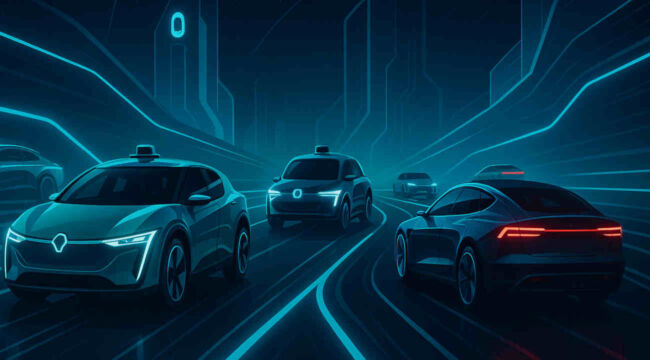Tesla’s Moment of Truth
Imagine owning a car that paid for itself.
A car that, when you don’t need it, is out earning money as a taxi.
This is the vision that Elon Musk has been pursuing, and promising to Tesla owners, since at least 2019.
Now, Tesla is scheduled to launch its first fleet of “robotaxis” in Austin next month. That’s only weeks away.
The performance of Tesla shares may depend on a successful launch of robotaxis in the near future. Competitors like Waymo are racing ahead, while Tesla’s core business has hit a slow-down. So Elon Musk has been putting heavy emphasis on robotaxis to drive future growth.
Tesla’s Sales Slowdown
In the first quarter of this year, Tesla sold 13% fewer cars than the same period last year. Revenue was down 9%, while net income fell by 71%.
Tesla lost ground in Europe, with car sales falling 36%, despite an overall 24% boost to electric vehicle (EV) sales on the continent.
Rising competition from European and Chinese EV makers threatens Tesla’s lucrative business. At one point Tesla had a virtual monopoly on EVs, but that era is over. Today the company faces stiff competition around the world.
While Elon’s political involvement with Donald Trump’s presidency certainly didn’t help sales, the primary threat is rising competition.
Much depends on Tesla getting a big piece of the lucrative robotaxi market.
The Multi-Trillion Dollar Robotaxi Market
When it comes to self-driving taxis, Tesla is also falling behind. Although the company has been working on the technology for more than a decade, they’ve lost ground to competitors like Google’s Waymo.
Waymo is currently selling “robotaxi” rides in 4 U.S. cities: Phoenix, LA, San Francisco, and Austin. These are self-driving taxis without a human driver. They do, however, have remote operators who can take over in an emergency.
Waymo is currently doing 250,000 robotaxi rides a week, up from 50,000 at this time last year. Google’s parent company is now in scaling mode with its self-driving program, and anyone else who wants a piece of this market should be on high alert.
Different Tech Visions
Waymo and Tesla have made extremely different technology choices. Waymo has chosen to go with as much technology as possible, using 13 cameras, 6 radars, 3 LiDARs (laser measurement devices), and external audio receivers.
 Waymo robotaxi with extensive sensor suite. Source: Wikipedia
Waymo robotaxi with extensive sensor suite. Source: Wikipedia
Waymo doesn’t believe that a reliable self-driving system can be created with vision alone. They include multiple different types of sensors to account for difficult conditions like rain, sun, and snow. It’s expensive, but Waymo clearly believes it’s worth the investment.
Tesla, on the other hand, has chosen to rely primarily on 11 cameras. They believe that with enough training data, a reliable self-driving system can be created with software and vision alone. Due to its large number of cars on the road, Tesla does have a huge advantage in terms of training data. If Tesla can pull it off, they’ll have a significant cost advantage over Waymo.
However, I am skeptical whether Tesla’s vision-based system will cut it for robotaxis. This is based on observations I’ve made watching videos of Tesla’s FSD (full-self driving), and the (limited) data we have to work with.
Miles Per Disengagement
The best statistic we have to judge success in self-driving is miles-per-disengagement (MPD).
This is the number of miles a self-driving car can go before needing human assistance. Waymo’s current MPD is at least 17,000 miles. So their self-driving taxis can drive a very long way without needing intervention.
Tesla has not released miles-per-disengagement, but there is a crowdsourced effort called the FSD Community Tracker. And Elon Musk has cited it in the past.
According to this crowdsourced data, Tesla’s current MPD in city driving is around 36. On the highway, it’s around 288.
That’s an average of 162 miles between disengagements. If this is even close to accurate, Tesla won’t be ready for robotaxis any time soon. Remember that Waymo’s reported number (in 2023) was 17,000 miles between disengagements.
If we assume Tesla needs to get close to Waymo’s number, there is still a long, long way to go.
Tesla: Priced for Robotaxi Perfection
Tesla (TSLA) currently trades at a lofty P/E ratio of 188. This is rather high. Toyota trades at a P/E of 7.5, while Ford trades at 8.6.
The market does not value Tesla as a car company, but as a tech firm. And in many ways, this makes sense. Tesla has massive potential with self-driving cars, humanoid robots, and its booming battery energy storage (Megapack) business.
But robotaxis are an existential issue for Tesla. As Musk himself said last year during an earnings call:
“If somebody doesn’t believe Tesla is going to solve autonomy [self-driving], I think they should not be an investor in the company.”
Now this issue is coming down to the wire. Tesla has promised to launch a small-scale robotaxi test in Austin in June. Elon said the initial phase will only involve about 10-20 cars, so investors aren’t expecting a material boost in revenue from this upcoming launch.
But they are expecting to see how well the company’s technology works in the real world. And whether a robotaxi network is in Tesla’s near future.
The most likely outcome from the June robotaxi launch is disappointment. But currently, investors appear to be pricing in a successful launch.
We’ll update readers once we know more about Tesla’s planned robotaxi launch in June.



Comments: